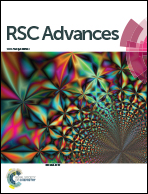Amine-functionalized metal organic framework (NH2-MIL-125(Ti)) incorporated sodium alginate mixed matrix membranes for dehydration of acetic acid by pervaporation
Abstract
In the present paper, amine-functionalized metal organic framework (NH2-MIL-125(Ti)) crystal nanoparticles were synthesized and incorporated into a sodium alginate (NaAlg) matrix to prepare novel NH2-MIL-125(Ti)/NaAlg mixed matrix membranes (MMMs). The prepared NH2-MIL-125(Ti) crystal nanoparticles and NH2-MIL-125(Ti)/NaAlg MMMs were characterized by the Fourier transformed infrared spectrum, X-ray diffraction, atomic force microscopy, transmission electron microscopy and contact angle goniometer. The pervaporation performance of the as-prepared NH2-MIL-125(Ti)/NaAlg MMMs have been tested and compared with a pristine NaAlg membrane for dehydrating acetic acid. The experimental results indicated that amine-functionalized NH2-MIL-125(Ti) crystal nanoparticles were confirmed as a promising filler to improve the separation performance of NH2-MIL-125(Ti)/NaAlg MMMs for water and acetic acid mixtures. Both the flux and selectivity of the NH2-MIL-125(Ti)/NaAlg MMMs were significantly improved by incorporating 6 wt% of NH2-MIL-125(Ti) nanoparticles. The pervaporation performances of NH2-MIL-125(Ti)/NaAlg-6 MMMs were greatly influenced by feed temperature, feed acetic acid concentration and feed flow rate. In a word, the as-prepared NH2-MIL-125(Ti)/NaAlg MMMs could be considered as potential candidates for practical acetic acid dehydration.


 Please wait while we load your content...
Please wait while we load your content...